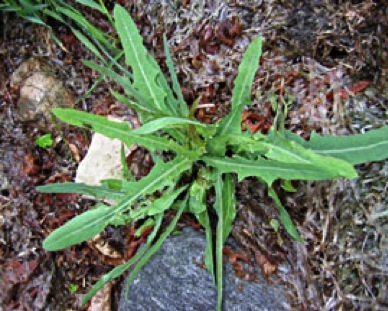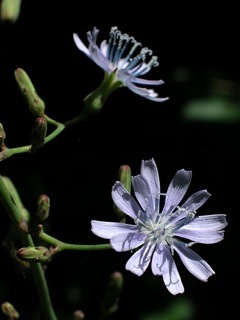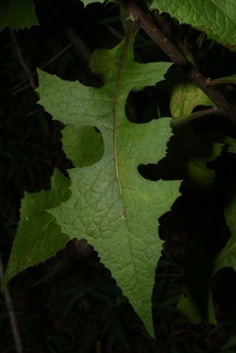
Lactuca Floridana early in the season
Lactuca floridana: Let Us Eat Wild Lettuce

Lactuca floridana has blue blossoms
Wild lettuce is not as tame as garden lettuce.
Garden lettuce is one of those nearly flavorless nearly nutritionless affectations of agriculture. Don’t misunderstand me: I like domesticated lettuce. But it is the milquetoast of the lettuce world. It’s genteel. Wild lettuce still has some kick to it. That kick is bitterness, which comes from the latex sap. Thus wild lettuce breaks one of the cardinal rules of foraging: Avoid white sap. It is one of a half dozen or so plants with white sap that is edible in some way. In the case of wild lettuce, boiling. When young the bitterness is less pronounced, and in some species is very mild or missing.

Note veins on leaves and uneven lobes
There are many species of wild lettuce. (See Lettuce Labyrinth) All grow rank as they age, so it is best to harvest them between four and 12 inches high. Woodland Lettuce tends to have lobed leaves on bottom and grassy leaves on top. Look for a V-shaped leaf stem and pure white milky sap. It’s one of my favorite spring time greens, boiled for about 10 minutes and served warm with olive oil and balsamic vinegar. Depending on size, I chop them up and eat stems and all.
Lactuca (lak-TOO-ka) is a Latin form of lac, an illusion to the milky sap. Floridana is Latin for of Florida. Some Lactuca, by the way, are diuretic, such as the L. scariola. The dried sap of some of the species, L. virosa, mimics opium but the sap is difficult to collect and it only puts one to sleep, temporarily
Green Deane’s “Itemized” Plant Profile
IDENTIFICATION: Plant has milky sap. Tall plant with lobbed green leaves, often powdery gray-green, dandelion-like flower cluster except blue, not yellow. The lactuca changes little in appearance from young to old, only growing larger, with more lobs on the leaves. End lobe on old leaves is arrow shaped. There can be much variation with some Lactuca having straight leaves with out any lobes at all. Look for flowers on many spikes rather than a cluster. The underside of lower leaves usually have a few hairs along the stem.
TIME OF YEAR: Spring time.
ENVIRONMENT: Lawns, fields, vacant lots, waste areas, parks.
METHOD OF PREPARATION: Young leaves in salads, tend to be bitter, older leaves boiled for 10/15 minutes. I like them with olive oil, vinegar, salt and pepper. Also eaten are L. canadensis, L. intybacea, L. scariola and L. muralis.

